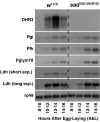Ecdysone and 20-hydroxyecdysone are not required to activate glycolytic gene expression in Drosophila melanogaster embryos
- PMID: 34870111
- PMCID: PMC8633990
- DOI: 10.17912/micropub.biology.000501
Ecdysone and 20-hydroxyecdysone are not required to activate glycolytic gene expression in Drosophila melanogaster embryos
Abstract
Many of the Drosophila enzymes involved in carbohydrate metabolism are coordinately up-regulated approximately midway through embryogenesis. Previous studies have demonstrated that this metabolic transition is controlled by the Drosophila Estrogen-Related Receptor (dERR), which is stabilized and activated immediately prior to onset of glycolytic gene expression. The mechanisms that promote dERR activity, however, are poorly understood and other transcriptional regulators could control this metabolic transition, independent of dERR. In this regard, the steroid hormone 20-hydroxyecdysone (20E) represents an intriguing candidate for regulating glycolytic gene expression in embryos - not only does the embryonic 20E pulse immediately precede transcriptional up-regulation of glycolytic metabolism, but 20E is also known to promote Lactate dehydrogenase gene expression. Here I test the hypothesis that embryonic 20E signaling is required to activate glycolytic gene expression. Using developmental northern blots, I demonstrate that the transcriptional up-regulation of glycolytic genes during embryogenesis still occurs in shadow mutants, which are unable to synthesize either ecdysone or 20E. My finding indicates that ecdysone and 20E signaling are not required for this mid-embryonic metabolic transition.
Copyright: © 2021 by the authors.
Figures

Similar articles
-
Hypoxia-inducible factor 1α is required to establish the larval glycolytic program in Drosophila melanogaster.Mol Metab. 2025 Mar;93:102106. doi: 10.1016/j.molmet.2025.102106. Epub 2025 Jan 31. Mol Metab. 2025. PMID: 39894213 Free PMC article.
-
20-hydroxyecdysone (20E) signaling regulates amnioserosa morphogenesis during Drosophila dorsal closure: EcR modulates gene expression in a complex with the AP-1 subunit, Jun.Biol Open. 2021 Aug 15;10(8):bio058605. doi: 10.1242/bio.058605. Epub 2021 Aug 17. Biol Open. 2021. PMID: 34296248 Free PMC article.
-
Hypoxia-inducible factor 1α is required to establish the larval glycolytic program in Drosophila melanogaster.bioRxiv [Preprint]. 2025 Jan 8:2025.01.07.631819. doi: 10.1101/2025.01.07.631819. bioRxiv. 2025. Update in: Mol Metab. 2025 Mar;93:102106. doi: 10.1016/j.molmet.2025.102106. PMID: 39829828 Free PMC article. Updated. Preprint.
-
G protein-coupled receptors function as cell membrane receptors for the steroid hormone 20-hydroxyecdysone.Cell Commun Signal. 2020 Sep 9;18(1):146. doi: 10.1186/s12964-020-00620-y. Cell Commun Signal. 2020. PMID: 32907599 Free PMC article. Review.
-
Drosophila Sgs genes: stage and tissue specificity of hormone responsiveness.Bioessays. 1996 Jan;18(1):47-54. doi: 10.1002/bies.950180110. Bioessays. 1996. PMID: 8593163 Review.
Cited by
-
Research Progress on the Regulation of Autophagy and Apoptosis in Insects by Sterol Hormone 20-Hydroxyecdysone.Insects. 2023 Nov 12;14(11):871. doi: 10.3390/insects14110871. Insects. 2023. PMID: 37999070 Free PMC article. Review.
References
-
- Chávez VM, Marqués G, Delbecque JP, Kobayashi K, Hollingsworth M, Burr J, Natzle JE, O'Connor MB. The Drosophila disembodied gene controls late embryonic morphogenesis and codes for a cytochrome P450 enzyme that regulates embryonic ecdysone levels. Development. 2000 Oct 01;127(19):4115–4126. - PubMed
-
- Currie PD, Sullivan DT. Structure and expression of the gene encoding phosphofructokinase (PFK) in Drosophila melanogaster. J Biol Chem. 1994 Oct 01;269(40):24679–24687. - PubMed
Grants and funding
LinkOut - more resources
Full Text Sources
Molecular Biology Databases
